Physical Address
304 North Cardinal St.
Dorchester Center, MA 02124
As with odontogenic cysts and tumors, any nonodontogenic tumor may cause jaw and facial swelling, pain, mobility of teeth, resorption of teeth roots, teeth displacement, and paresthesia. The symptoms and signs depend on the size of lesions, how long the lesions have been present, how rapidly they are growing, whether they are benign or malignant, and the involvement of nerves, especially the inferior alveolar nerve that may lead to paresthesia or numb chin syndrome. Evaluation of imaging studies is crucial for rendering an accurate diagnosis. Many advances have occurred in understanding the molecular basis for some of these conditions ( Table 17.1 ).
| Condition | More Common Genomic Changes | Less Common Genomic Changes |
|---|---|---|
| Familial adenomatous polyposis syndrome | Mutation in APC | |
| Fibrous dysplasia including McCune-Albright syndrome | Mutation in GNAS | |
| Juvenile trabecular and psammomatoid ossifying fibroma | Amplification of MDM2 and RASAL1 | |
| Psammomatoid ossifying fibroma | Breakpoints on Xq26 and 2q33 | |
| Central giant cell granuloma | Mutation in TRPV4 , KRAS , FGFR1 | |
| Giant cell tumor of long bones | Mutation in H3F3A | |
| Noonan syndrome | Mutation in PTPN11, SOS1, RAF1 | |
| Aneurysmal bone cyst | Rearrangement in USP6 often with CDH11 as fusion partner | Other fusion partners include CNBP, COL1A1, CTNNB1, FOSL2, RUNX2, SPARC, FAT1 |
| Cherubism | Mutation in SH3BP2 | |
| Autosomal recessive intraosseous vascular malformation | Mutation in ELMO2 | |
| Osteoid osteoma and osteoblastoma | FOS and FOSB rearrangement; fusion partners include ANKH and RUNX2 | COL1A1::FYN fusion and deletion of NF2 in epithelioid osteoblastoma |
| Osteosarcoma | Mutations in TP53 and RB1 | |
| Synovial chondromatosis | FN1::ACVR2A fusion | FN1::NFATc2 fusion |
| Chondromyxoid sarcoma | Rearrangements and upregulation of GRM1 | |
| Chondrosarcoma | Mutation in IDH1 and IDH2, COL2A1, TP53, and RB1 | H3F3B mutation in some clear cell chondrosarcomas KMT2A::BCOR fusion in chondrosarcoma arising from synovial chondromatosis |
| Mesenchymal chondrosarcoma | HEY1::NCOA2 fusion | IRF2BP2::CDX1 fusion |
| Paget disease of bone | Mutation in SQSTM1 , more in inherited than sporadic cases | Mutation in ZNF687 noted in associated giant cell tumors |
| Langerhans cell histiocytosis | Mutations in BRAF V600E and MAP2K and MEK1 which are mutually exclusive | Mutations in ERBB3 , NRAS, and KRAS |
| Ewing sarcoma | EWSR1 :: FLI1 | Other fusion partners with EWSR1 include ETS genes such as ERG, FEV , ETV1, ETV4, and ZSG; rarely FUS::ERG fusion |
| Rhabdomyosarcoma with TFCP2 rearrangement | FUS::TFCP2 and EWSR1::TFCP2 fusion | MEIS1::NCOA2 |
Tori: These occur in 10% to 30% of adults and present as exophytic, hard, uninodular or multinodular bony masses covered by mucosa. Torus palatinus is more common and is located on the midline of palate while torus mandibularis occurs on the lingual mandible and tends to be bilateral and symmetric; they may grow to a large size ( Fig. 17.1 A–B). They are readily traumatized and ulcerated because of their protuberant nature or may exhibit frictional keratosis and ulceration; 2% of patients have both palatal and mandibular tori. Mandibular tori appear as radiopacities in dental films.
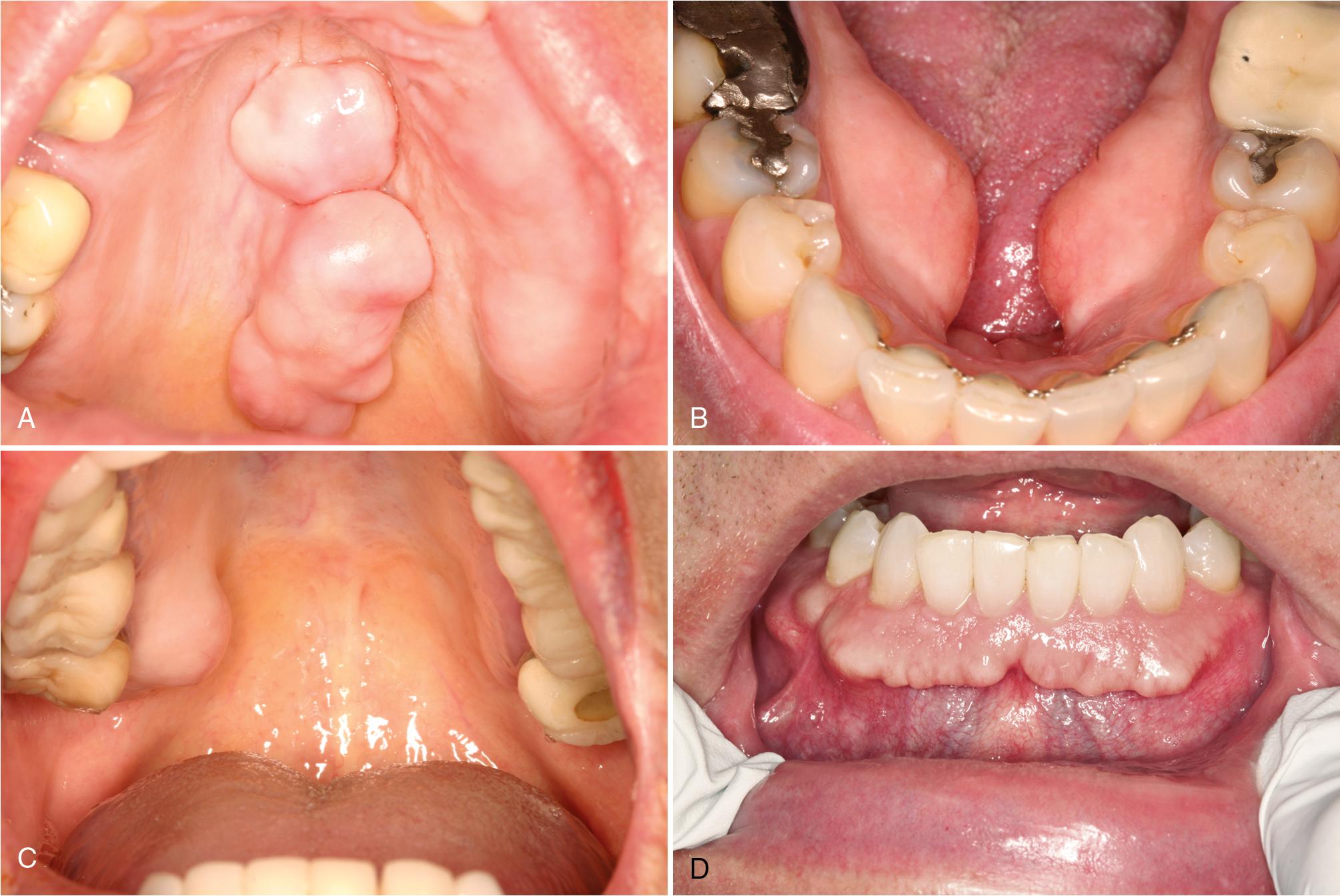
Exostosis: This occurs in up to 27% of adults with a 5:1 male predilection and presents as an outgrowth of bone, polypoid, sessile, or shelf-like, frequently on buccal aspects of the mandible, maxilla, or ascending arch of the palate, with more than 90% of cases having concurrent tori ( Fig. 17.1 C–D); exostoses may show rapid growth in some patients. They appear as radiopacities in dental films.
Subpontic osseous hyperplasia (subpontic exostosis): This is an outgrowth of bone beneath a pontic (artificial tooth on a bridge that replaces a missing tooth) that generally develops more than 10 years after placement of the fixed prosthesis. It causes discomfort in approximately 12% of patients, and radiographically is indistinguishable from normal bone, although there may be some osteosclerosis ( Fig. 17.1 E).
Osteoma: Periosteal osteoma arises from the surface of the bone and causes a noticeable mass either in the oral cavity or palpable on the skin overlying the mandible where it is more prevalent ( Fig. 17.1 F). Endosteal osteomas are asymptomatic and noted incidentally on radiographs as round or ovoid homogeneous radiopacities without a surrounding radiolucent rim ( Fig. 17.1 G). Large ones may displace tooth roots. Sino-orbital osteomas affect the maxillary sinus in approximately 10% of cases.
Tori are inherited in an autosomal dominant fashion and may exhibit ethnic differences. Exostoses may develop as a result of genetic and environmental factors and some have suggested that parafunctional habits such as bruxing play a role. Subpontic osseous hyperplasia results from irritation of bone beneath the pontic, leading to bone deposition. Multiple osteomas are associated with familial adenomatous polyposis syndrome which is an autosomal dominant condition associated with mutation in APC ( Fig. 17.1 H). This syndrome is also associated with the development of supernumerary teeth and odontomas, colonic polyps that develop in childhood and adolescence that are highly associated with the development of colorectal carcinoma at a young age, desmoid tumors, fibromas, thyroid carcinomas, hepatoblastoma, pancreatobiliary tumors, nasopharyngeal angiofibromas, retinal pigmentary disorder, and epidermoid cysts. Gardner syndrome is one variant of this syndrome.
Tori, exostoses, osseous hyperplasia, and osteomas have similar histopathology. There is dense lamellar bone with well-spaced small osteocytes within lacunae, variable fibrosis, and usually inconspicuous osteoblastic rimming, unless inflamed; fatty marrow is often present ( Fig. 17.2 A–B). Lamellar bone is characterized by long, sweeping collagen bundles viewed through polarized light ( Fig. 17.2 C).
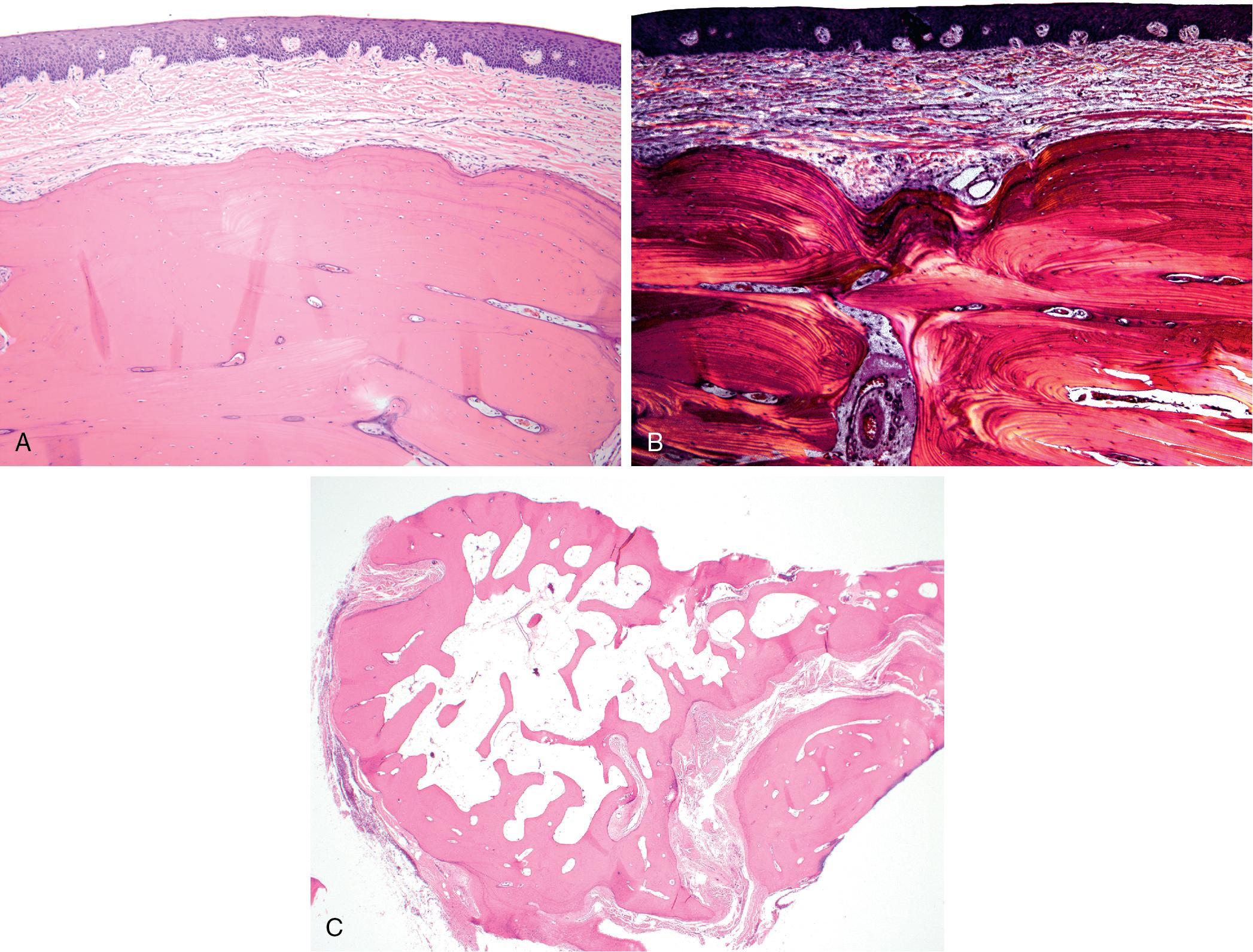
Sino-orbital osteomas may show osteoblastomatous foci.
Osteochondroma occurs mostly on the coronoid and condylar processes in young adults and because of its location may cause swelling and trismus. It appears as a nodule of bone with a benign cartilaginous cap. Coronoid osteochondromas have been reported in patients with hereditary multiple exostoses syndrome , an autosomal dominant condition caused by mutations in EXT1 that produces exostosin-1 and exostosin-2 that are involved in the development of multiple osteochondromas in the long and flat bones.
Excision is performed usually in preparation for denture fabrication, or if the lesion is constantly ulcerated from trauma.
Auskalnis A, Rutkunas V, Bernhardt O, Sidlauskas M, Salomskiene L, Baseviciene N. Multifactorial etiology of Torus mandibularis: study of twins. Stomatologija. 2015;17:35-40.
Aydin U, Yildirim D, Bozdemir E. Subpontic osseous hyperplasia: three case reports and literature review. Eur J Dent. 2013;7:363-367.
Brooks JK, Powers LK. Subpontic osseous hyperplasia: comprehensive review of the literature and presentation of new case history. Int J Prosthodont. 2019;32:339-344.
Chohayeb AA, Volpe AR. Occurrence of torus palatinus and mandibularis among women of different ethnic groups. Am J Dent. 2001;14: 278-280.
Clifford T, Lamey PJ, Fartash L. Mandibular tori, migraine and temporomandibular disorders. Br Dent J. 1996;180:382-384.
Dinarvand P, Davaro EP, Doan JV, et al. Familial adenomatous polyposis syndrome: an update and review of extraintestinal manifestations. Arch Pathol Lab Med. 2019;143:1382-1398.
Islam MN, Cohen DM, Waite MT, Bhattacharyya I. Three cases of subpontic osseous hyperplasia of the mandible: a report. Quintessence Int. 2010;41:299-302.
Jainkittivong A, Langlais RP. Buccal and palatal exostoses: prevalence and concurrence with tori. Oral Surg Oral Med Oral Pathol Oral Radiol Endod. 2000;90:48-53.
Larrea-Oyarbide N, Valmaseda-Castellon E, Berini-Aytes L, Gay-Escoda C. Osteomas of the craniofacial region. Review of 106 cases. J Oral Pathol Med. 2008;37:38-42.
Lease LR. Correlations between dental wear and oral cavity characteristics: mandibular torus, palatine torus, and oral exostoses. Am J Hum Biol. 2021;33:e23446.
Roychoudhury A, Bhatt K, Yadav R, Bhutia O, Roychoudhury S. Review of osteochondroma of mandibular condyle and report of a case series. J Oral Maxillofac Surg. 2011;69:2815-2823.
McHugh JB, Mukherji SK, Lucas DR. Sino-orbital osteoma: a clinicopathologic study of 45 surgically treated cases with emphasis on tumors with osteoblastoma-like features. Arch Pathol Lab Med. 2009;133: 1587-1593.
Ruiz LP, Lara JC. Craniomaxillofacial features in hereditary multiple exostosis. J Craniofac Surg. 2012;23:e336-338.
Telang LA, Telang A, Nerali J, Pradeep P. Tori in a Malaysian population: morphological and ethnic variations. J Forensic Dent Sci. 2019;11: 107-112.
Yu J, Yang T, Dai J, Wang X. Histopathological features of condylar hyperplasia and condylar osteochondroma: a comparison study. Orphanet J Rare Dis. 2019;14:293.
These are likely related conditions that result in sclerosis of bone and some investigators do not differentiate between the two.
Condensing osteitis: This occurs in 1% to 6% of the population and there is an asymptomatic poorly demarcated but discrete homogeneous radiopacity seen around the apices and roots of teeth. These are usually mandibular premolars and molars that are nonvital and have been endodontically treated. Widening of the periodontal ligament space should raise the suspicion that the associated tooth is nonvital ( Fig. 17.3 A–B).
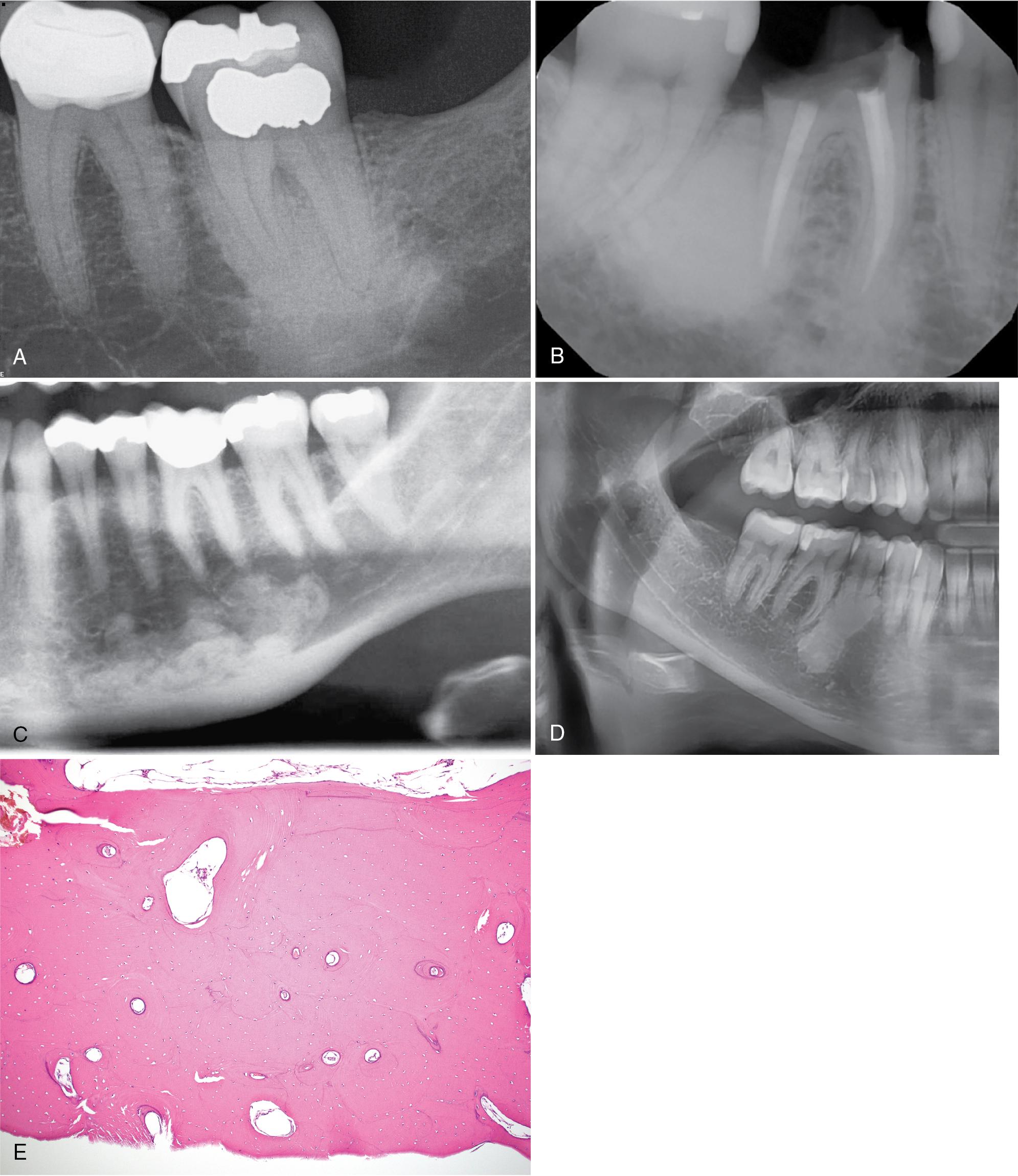
Idiopathic osteosclerosis (dense bone island, bone scar): This occurs in approximately 1% to 6% of the population and may be more prevalent in women, especially in the East Asian population. It presents as an asymptomatic poorly demarcated but discrete radiopacity that is usually not located at the apices of teeth. It occurs in the mandible in greater than 80% of cases usually in the premolar–molar area, is discovered on routine radiography, and is unassociated with pain or swelling. If associated with apices of teeth, vitality testing of teeth should be performed ( Fig. 17.3 C–D).
Condensing osteitis likely is caused by inflammation of odontogenic origin (usually from a nonvital tooth) leading to reactive bone formation and sclerosis. Idiopathic osteosclerosis is of unknown etiology.
Both have similar histopathology and exhibits densely sclerotic bone with few or small Haversian canals; fibrosis, fatty marrow, and mild chronic inflammation may be present ( Fig. 17.3 E).
Endosteal osteoma may appear similar to idiopathic osteosclerosis and condensing osteitis although in reactive conditions, the radiopacity tends to have an irregular shape rather than being round or ovoid. In either case, no treatment is necessary except for evaluation for familial adenomatous polyposis syndrome when multiple osteomas are present.
Biopsy is not necessary if the lesion is recognized for what it is on the radiograph. When idiopathic osteosclerosis occurs at the apices of teeth not previously endodontically treated, the teeth should be evaluated for vitality.
Gamba TO, Maciel NAP, Rados PV, da Silveira HLD, Arus NA, Flores IL. The imaging role for diagnosis of idiopathic osteosclerosis: a retrospective approach based on records of 33,550 cases. Clin Oral Investig. 2021;25:1755-1765.
Green TL, Walton RE, Clark JM, Maixner D. Histologic examination of condensing osteitis in cadaver specimens. J Endod. 2013;39:977-979.
MacDonald-Jankowski DS. Idiopathic osteosclerosis in the jaws of Britons and of the Hong Kong Chinese: radiology and systematic review. Dentomaxillofac Radiol. 1999;28:357-363.
MacDonald D, Yu W. Incidental findings in a consecutive series of digital panoramic radiographs. Imaging Sci Dent 2020;50:53-64.
Miloglu O, Yalcin E, Buyukkurt MC, Acemoglu H. The frequency and characteristics of idiopathic osteosclerosis and condensing osteitis lesions in a Turkish patient population. Med Oral Patol Oral Cir Bucal. 2009;14:e640-e645.
Verzak Z, Celap B, Modric VE, et al. The prevalence of idiopathic osteosclerosis and condensing osteitis in Zagreb population. Acta Clin Croat. 2012;51:573-577.
Wijn MA, Keller JJ, Giardiello FM, Brand HS. Oral and maxillofacial manifestations of familial adenomatous polyposis. Oral Dis. 2007;13: 360-365.
Yonetsu K, Yuasa K, Kanda S. Idiopathic osteosclerosis of the jaws: panoramic radiographic and computed tomographic findings. Oral Surg Oral Med Oral Pathol Oral Radiol Endod. 1997;83:517-521.
Unlike other bones, infection and inflammation of the jawbones (osteitis) is a common occurrence because teeth frequently become infected, either from caries or periodontal disease, with spread of such infection into the bone. Periapical lesions, such as periapical granuloma and apical radicular cysts when large, result in intramedullary inflammation, usually without sequestrum formation. Even large periapical abscesses heal after curettage, often without the necessity for prolonged antibiotic use.
Acute and chronic suppurative bacterial osteomyelitis of the jaws is usually the result of chronic odontogenic and/or jawbone infection such as after a fracture, and is associated with sequestrum formation. A second form of osteomyelitis is not associated with bacterial infection and is termed chronic nonbacterial osteomyelitis . Previous terms used for this condition include primary diffuse osteomyelitis and primary diffuse sclerosing osteomyelitis . It is now an umbrella term under which includes chronic recurrent multifocal osteomyelitis (CRMO) when lesions are multifocal, as well as a syndrome consisting of synovitis, acne, pustulosis, hyperostosis, and osteomyelitis (SAPHO) that tends to occur in adults.
Osteonecrosis of the jaw is defined as the presence of sequestrum often exposed to the oral cavity and has a number of etiologies ( Table 17.2 ). Unlike the long bones, the presence of sequestrum does not always connote osteomyelitis as defined in the long bones. Two examples of this to illustrate the difference are benign spontaneous sequestration of the lingual plate and stage 1 medication-related osteonecrosis of the jaws, both of which are painless and often resolve spontaneously. As such, osteonecrosis with sequestrum formation in the jaws does not carry the same prognosis as long bone osteomyelitis.
| Etiology | Clinical Findings | Management and Prognosis |
|---|---|---|
| Medication-induced: antiresorptive agents such as bisphosphonates and denosumab, and antiangiogenic agents such as bevacizumab, aflibercept, and tyrosine kinase inhibitors such as sunitinib; occurs in 1%–3% of cancer patients on bisphosphonates and denosumab and 1 in 500–2000 patients on bisphosphonates for nononcologic indications | Staging (for medication group):
|
|
| Radiation causes damage to bone and sclerosis of vessels leading to hypovascularity; up to 5% frequency after irradiation with >6000 cGys | Exposed bone Maxilla/mandible = 1:9 probably because mandible has less collateral circulation compared with maxilla |
Chlorhexidine rinse, antibiotics, surgical excision/resection, hyperbaric oxygen, pain control Prognosis: often difficult to control with progression or recurrence occur frequently |
| Mechanical Trauma | ||
| Intubation-associated or spontaneous benign sequestration of lingual plate | Both on mylohyoid ridge | Nonsurgical sequestrectomy or allow bone to exfoliate; chlorhexidine rinse; topical analgesia Prognosis: does not recur |
| Chemical Trauma | ||
| Cocaine Caustic dental materials (e.g., root canal medications) |
Cocaine necrosis often seen on palate Site where dental materials placed |
Cocaine necrosis: surgery Prognosis: recurrence if cocaine habit maintained Dental materials: debridement and gentle saltwater rinses Prognosis: good |
| Infection | ||
| Odontogenic infection or fracture site | Site of infected tooth, extraction of infected tooth, or fracture site | Chlorhexidine rinse, antibiotics, curettage, debridement, surgical excision, pain control |
| Varicella-zoster | Unilateral exposed bone, with preceding gingival/palatal ulceration | Chlorhexidine rinse, antiviral treatment, surgical excision/resection, pain control Prognosis: no recurrence |
| Noma, necrotizing ulcerative stomatitis (NUS) | Around teeth and soft tissues; immunocompromised or HIV/AIDS-related | Improve nutrition, antibiotics, plastic surgery to correct soft tissue defects; treat HIV/AIDS Prognosis: may recur if underlying medical issues not adequately addressed |
| Sclerotic bone disease such as mature cementoosseous dysplasia (especially multifocal type), Paget disease, and osteopetrosis (hypovascular bone) in presence of odontogenic infection | Where bone disease and odontogenic infection coexist with/without history of extraction and oral surgery | Chlorhexidine rinse, antibiotics, curettage, debridement, surgical excision/resection, pain control Prognosis: may recur |
| Thrombophilic and hypofibrinolytic conditions | Same as medication-induced lesions | Same as medication-induced lesions |
Suppurative osteomyelitis , acute and chronic: This usually occurs in adults and is associated with a chronic tooth infection either of pulpal or periodontal origin, postextraction of infected teeth, or a poorly healed jaw fracture ( Fig. 17.4 A). There is pain and swelling, and suppuration and sinus tracts may be present with some symptom-relief when there is drainage.
Patients with focal or multifocal cementoosseous dysplasia with sclerotic avascular cementoosseous masses are at risk for developing such osteomyelitis ( Fig. 17.4 B).
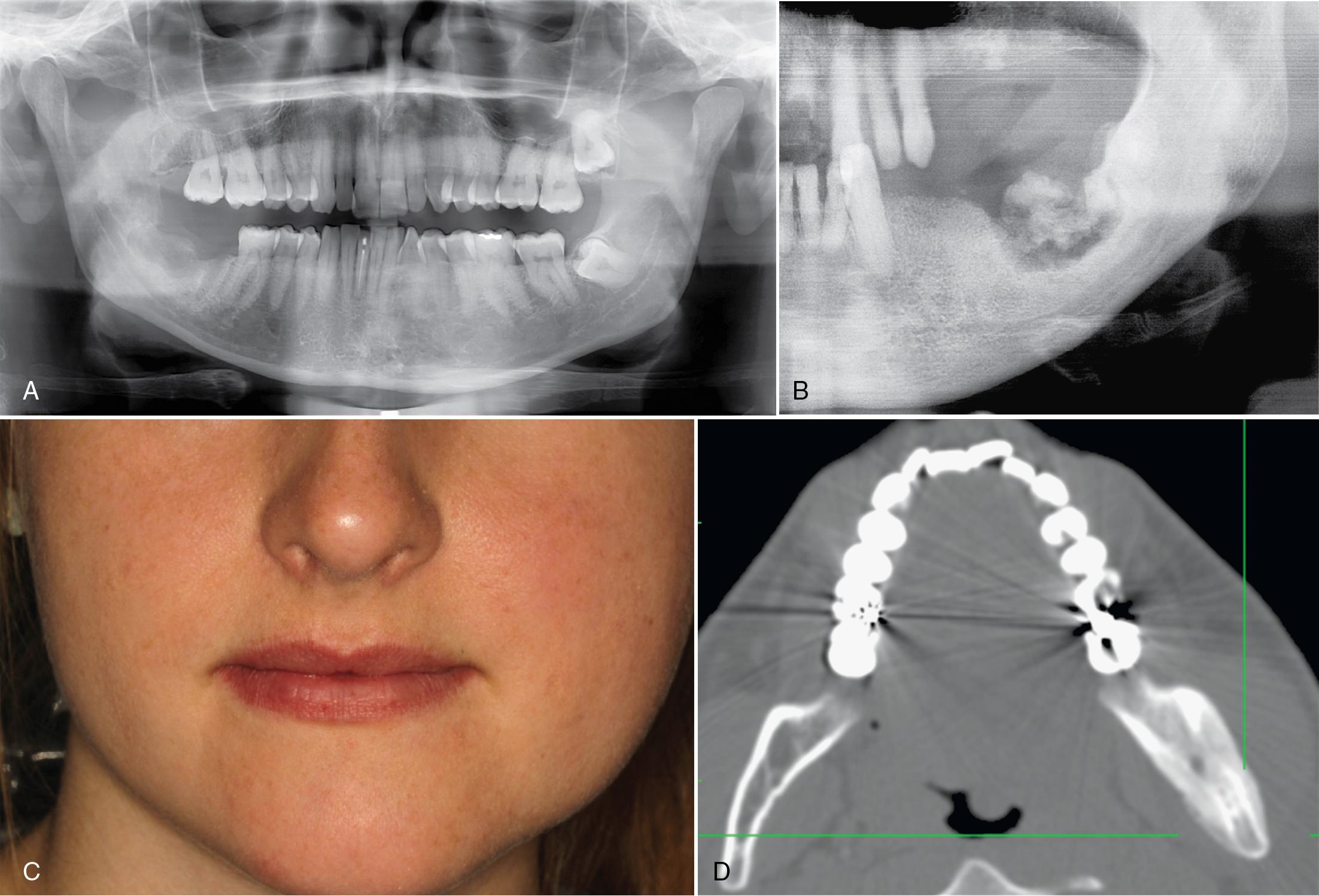
Chronic nonbacterial osteomyelitis:
The majority (>95% of cases) occur before age 20 with a 2:1 female predilection, and there is intermittent pain, swelling, trismus, and intermittent fever with little response to antibiotics ( Fig. 17.4 C). The mandible is one of the bones commonly affected, together with metaphases of long bones, vertebra, and clavicles. Patients often begin with involvement of one bone and approximately 80% develop involvement of other bones (CRMO). Patients may exhibit acne, palmar-plantar pustulosis, inflammatory arthritis, and other autoinflammatory conditions such as psoriasis and inflammatory bowel disease although this is more common in adults with SAPHO syndrome who more frequently exhibit involvement of the sternum and clavicle.
Radiographs show diffuse expansion of the mandible with a ground-glass appearance, osteosclerosis, and small osteolytic foci ( Fig. 17.4 D).
Normal complete blood count, and elevated erythrocyte sedimentation rate (ESR) and C-reactive protein (CRP) and abnormal radiographic findings are key to the diagnosis.
Osteonecrosis:
This presents as bony sequestrum, usually exposed, with or without pain ( Fig. 17.5 A–D). In the case of medication-related osteonecrosis, chronic sinus tracts and nonhealing extraction sockets present for more than 6 months and usually years after tooth extraction are common manifestations. Radiographs reveal thickened lamina dura, osteosclerosis, and persistent extraction sockets, with advanced cases exhibiting mottled radiolucency and radiopacities consistent with sequestra ( Table 17.2 ; Fig. 17.5 E–F).
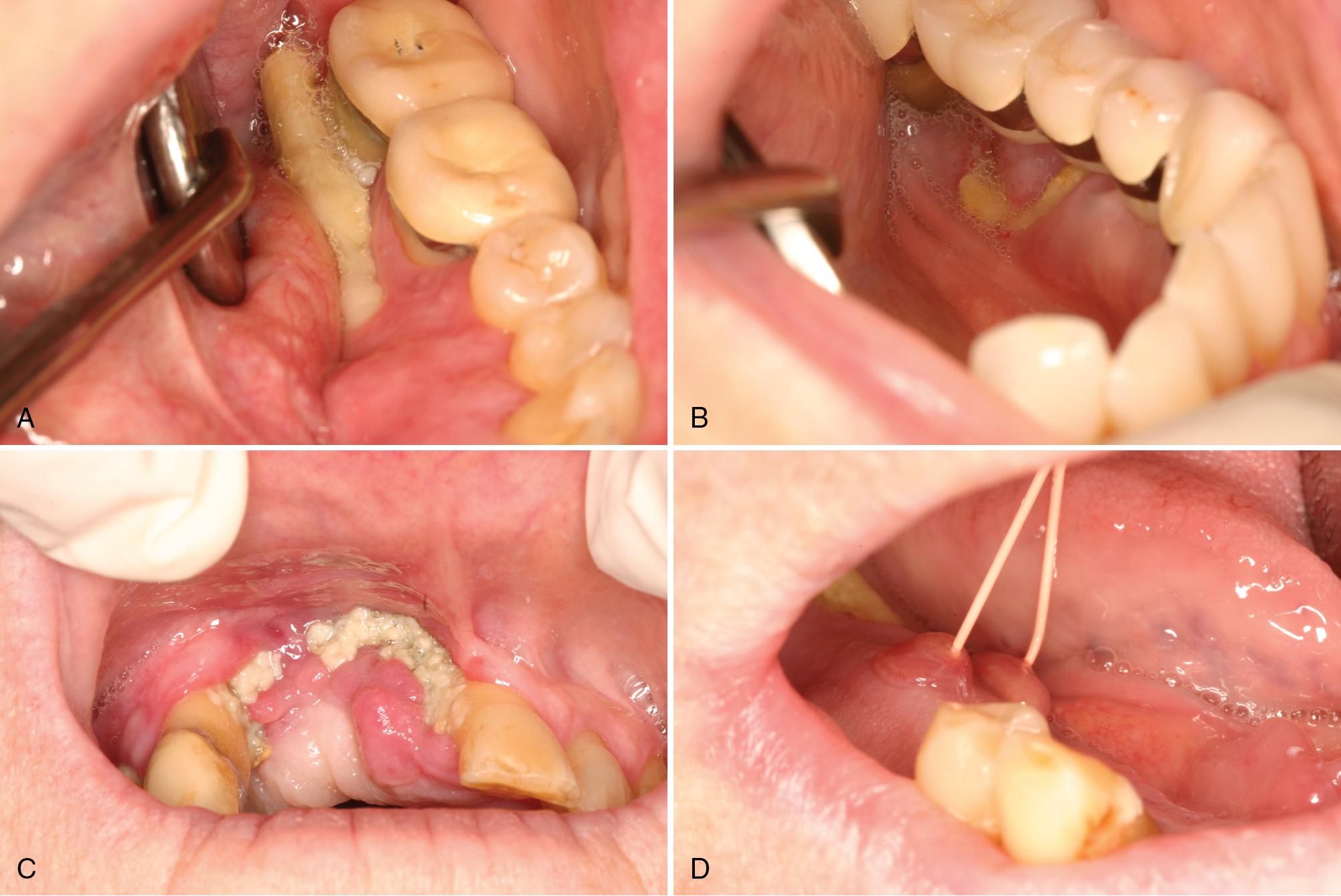
Benign spontaneous sequestration of the lingual plate:
This occurs in healthy individuals in the fourth to sixth decades, with a 1.8:1 male predilection, and consists of small, 0.1 to 1.0 cm sequestra noted on the mylohyoid ridge ( Fig. 17.5 G). These heal spontaneously after the sequestrum exfoliates or is removed. There is no underlying radiolucency.
Suppurative osteomyelitis is caused by a bacterial infection from a tooth or nonhealing fracture site. Most cases (66%) are polymicrobial although streptococcus viridans is the most commonly isolated organism. Primary nonbacterial sclerosing osteomyelitis of the mandible in children and adolescents is an autoinflammatory rheumatologic condition that is likely caused by persistent activation of the innate immune system pathways in a susceptible host, and is the monostotic form of CRMO that usually affects the lower limbs, pelvis, and clavicle with skin lesions as noted earlier. SAPHO syndrome is the adult equivalent. Causes of osteonecrosis include suppression of bone turnover especially by medications used to treat osteoporosis and cancer involving the bone which includes antiresorptive medications, antiangiogenic medications, some tyrosine kinase inhibitors, and other targeted therapies. Vascular compromise, trauma, and infection are important contributing factors (see Table 17.2 ).
Small pieces of sequestra exteriorize naturally when it lies near the surface of the bone and epithelium grows downward and together with granulation tissue, separates the sequestrum from the underlying vital bone; this process also applies to failed bone grafts ( Fig. 17.6 A–B).
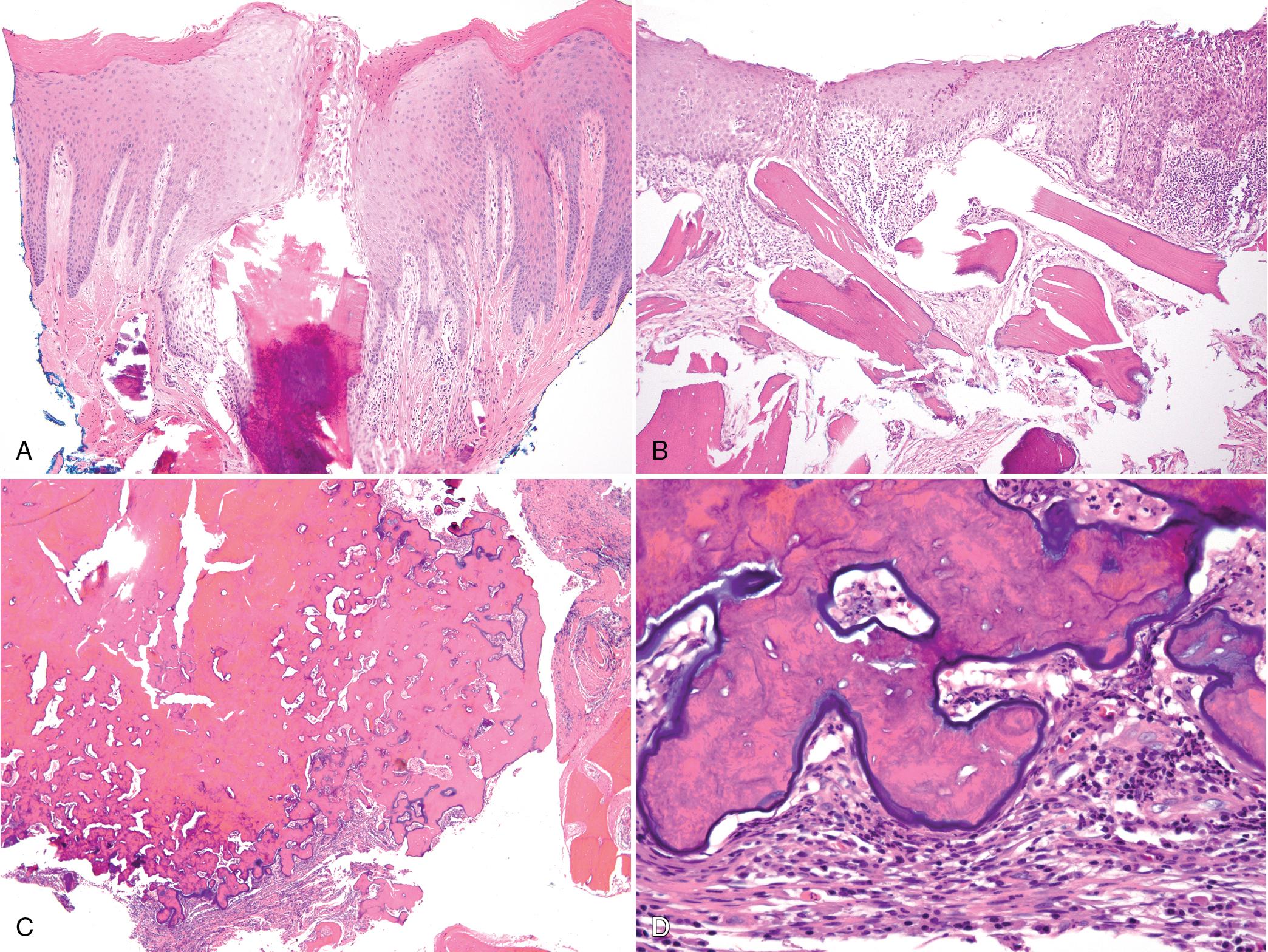
Suppurative osteomyelitis: There are nonviable bony sequestra and granulation tissue with acute and chronic inflammation and abscesses; a sclerotic mass of nonvital globular sclerotic cementoosseous material may be present if there is a preexisting cementoosseous dysplasia (see Fig. 17.6 C–D).
Chronic nonbacterial osteomyelitis: The reactive and reparative osteoid forms parallel bone trabeculae or exhibit an interlacing pattern. There is prominent stromal fibrosis, mild to insignificant chronic inflammation, dilated sinusoidal vessels, and rarely sequestrum. Other features include a fibrous dysplasia–like pattern and atypical osteoid formation ( Fig. 17.7 ).
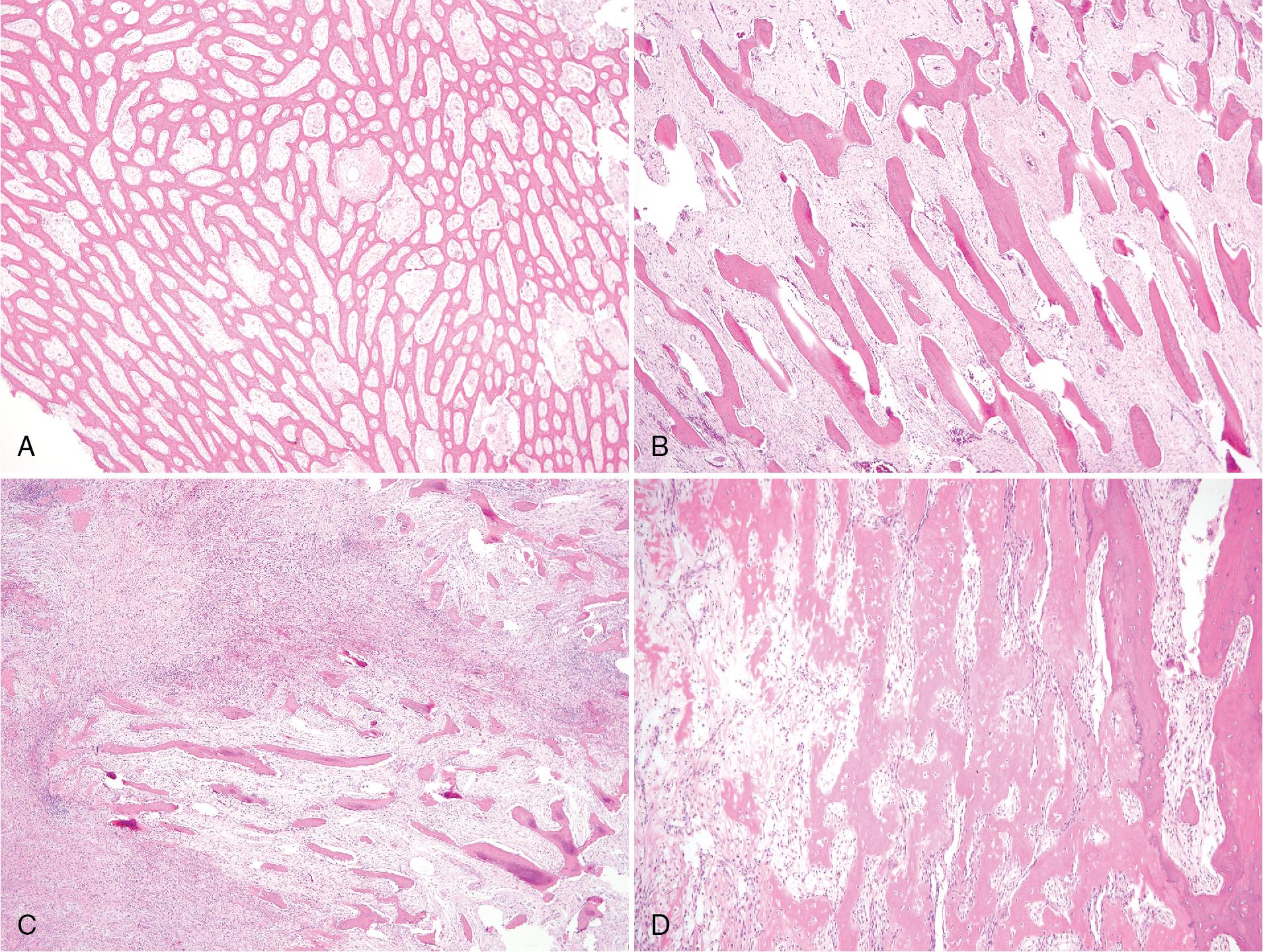
Osteonecrosis of other etiologies including osteoradionecrosis: There are nonviable bony sequestra with empty lacunae and ragged resorptive defects, often with extensive bacterial colonization especially with Actinomycetes species within the biofilm ( Figs. 17.8 and 17.9 ). A diagnosis of actinomycosis (actinomycotic osteomyelitis) should be made only if sulfur granules are present, surrounded by suppuration with Splendore-Hoeppli effect resulting from host reponse to the bacteria ( Fig. 4.3 C–D); Eikenella corrodens is often present. Osteoclasts may be seen, often detached from the surface of the sequestra in bisphosphonate-associated osteonecrosis, and there may be extensive pseudoepitheliomatous hyperplasia ( Fig. 17.10 ).
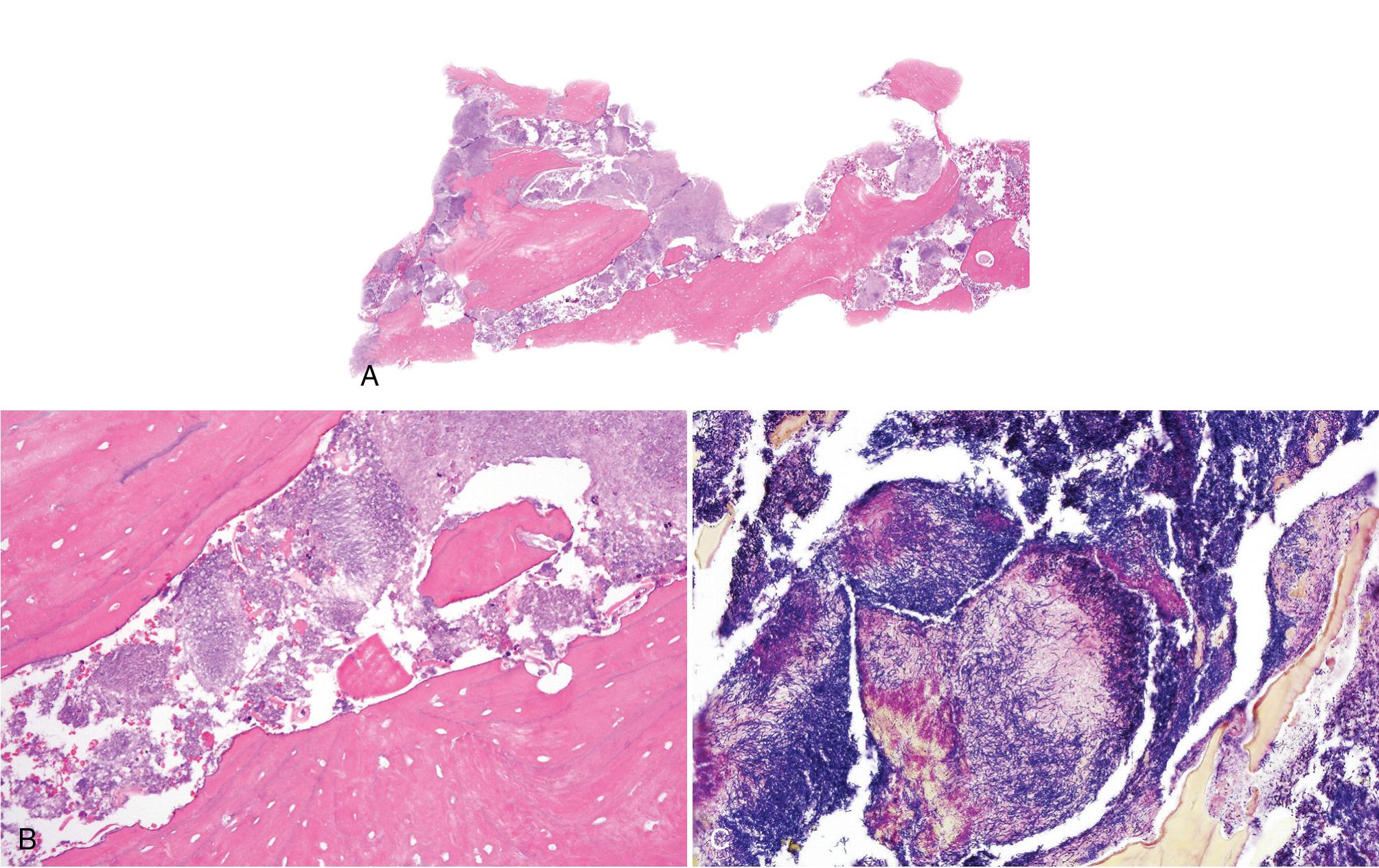

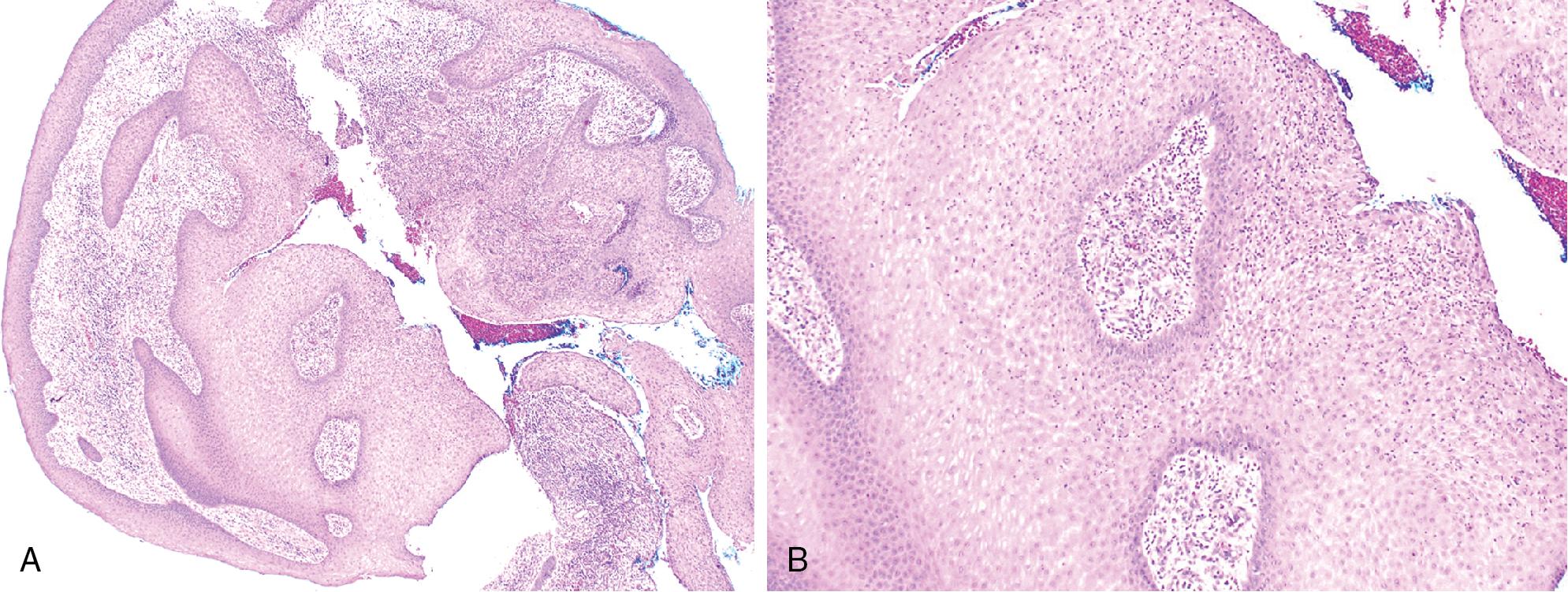
Atypical osteoid and fibrous dysplasia–like areas in chronic nonbacterial osteomyelitis must always be correlated with the clinical findings; an incorrect diagnosis of fibrous dysplasia or osteosarcoma may be rendered when these features are taken out of context and especially if the biopsy is small.
A search should be made for primary bone malignancy (such as myeloma) or metastatic disease for patients with cancer who develop medication-related osteonecrosis.
Recurrent squamous cell carcinoma is a consideration for the pseudoepitheliomatous hyperplasia often noted adjacent to osteoradionecrosis.
Bone graft material (such as freeze-dried bone) presents as fragments of necrotic bone and can be differentiated from native sequestra by the regularity in shape and size and even distribution of the osseous particles; it also shows appositional host bone on the surface in most cases ( Fig. 17.11 ).

Suppurative osteomyelitis: Sequestrectomy and debridement, long-term antibiotics (β-lactams and clindamycin), and hyperbaric oxygen are recommended treatments.
Chronic nonbacterial osteomyelitis: Treatment is with nonsteroidal antiinflammatory drugs, corticosteroids; anti–tumor necrosis factor alpha (TNFα) inhibitors, and bisphosphonates. Relapse is common.
Medication-related osteonecrosis: Nonviable bone is often readily removed by nonsurgical sequestrectomy or dislodgement, surgical sequestrectomy and debridement, or resection and antibiotics depending on the stage ( Table 17.2 ; Fig. 17.12 ); hyperbaric oxygen may be useful in severe cases. However, in patients on antiresorptive therapies or anticancer therapies, osteonecrosis may not completely resolve because of the need for patients to be on such therapies. Treatment is directed towards relief of symptoms and prevention of infections.

Almazrooa SA, Woo SB. Bisphosphonate and nonbisphosphonate-associated osteonecrosis of the jaw: a review. J Am Dent Assoc. 2009;140: 864-875.
Almazrooa SA, Chen K, Nascimben L, et al. Case report: osteonecrosis of the mandible after laryngoscopy and endotracheal tube placement. Anesth Analg. 2010;111:437-441.
Badescu MC, Rezus E, Ciocoiu M, et al. Osteonecrosis of the jaws in patient with hereditary thrombophilia/hypofibrinolysis - from pathophysiology to therapeutic implications. Int J Mol Sci 2022; 23(2): 640. https://doi.org/10.3390/ijms23020640 .
Cianci F, Zoli A, Gremese E, Ferraccioli G. Clinical heterogeneity of SAPHO syndrome: challenging diagnose and treatment. Clin Rheumatol 2017;36:2151-2158.
Dym H, Zeidan J. Microbiology of acute and chronic osteomyelitis and antibiotic treatment. Dent Clin North Am. 2017;61:271-282.
Eguia A, Bagan-Debon L, Cardona F. Review and update on drugs related to the development of osteonecrosis of the jaw. Med Oral Patol Oral Cir Bucal. 2020;25:e71-e83.
Hansen T, Kunkel M, Weber A, Kirkpatrick CJ. Osteonecrosis of the jaws in patients treated with bisphosphonates—histomorphologic analysis in comparison with infected osteoradionecrosis. J Oral Pathol Med. 2006;35:155-160.
Krakowiak PA. Alveolar osteitis and osteomyelitis of the jaws. Oral Maxillofac Surg Clin North Am. 2011;23:401-413.
Kumar SK, Gorur A, Schaudinn C, et al. The role of microbial biofilms in osteonecrosis of the jaw associated with bisphosphonate therapy. Curr Osteoporos Rep. 2010;8:40-48.
Lenert A, Ferguson PJ. Comparing children and adults with chronic nonbacterial osteomyelitis. Curr Opinion Rheumatol. 2020;32:421-426.
Mawardi H, Enzinger P, McCleary N, et al. Osteonecrosis of the jaw associated with ziv-aflibercept. J Gastrointest Oncol. 2016;7:e81-e87.
Padwa BL, Dentino K, Robson CD, et al. Pediatric chronic nonbacterial osteomyelitis of the jaw: clinical, radiographic and histopathologic features. J Oral Maxillofac Surg. 2016;74:2393-2402.
Peters E, Lovas GL, Wysocki GP. Lingual mandibular sequestration and ulceration. Oral Surg Oral Med Oral Pathol. 1993;75:739-743.
Ruggiero SL, Dodson TB, Aghaloo T, et al. American Association of Oral and Maxillofacial Surgeons position paper on medication-related osteonecrosis of the jaw–2022 update. J Oral Maxillofac Surg. 2022;80:920-943.
Schnabel A, Range U, Hahn G, Berner R, Hedrich CM. Treatment response and longterm outcomes in children with chronic nonbacterial osteomyelitis. J Rheumatol. 2017;44:1058-1065.
Tlougan BE, Podjasek JO, O’Haver J, et al. Chronic recurrent multifocal osteomyelitis (CRMO) and synovitis, acne, pustulosis, hyperostosis, and osteitis (SAPHO) syndrome with associated neutrophilic dermatoses: a report of seven cases and review of the literature. Pediatr Dermatol. 2009;26:497-505.
Wipff J, Costantino F, Lemelle I, et al. A large national cohort of French patients with chronic recurrent multifocal osteitis. Arthritis Rheumatol. 2015;67:1128-1137.
Fibroosseous lesions are a heterogeneous group of lesions composed of inflammatory/reactive conditions, developmental/metabolic bone disorders, and neoplasms. They are characterized by a cellular proliferation of plump fibroblast-like cells and deposition of woven bone and osteoid, and/or cementum-like material composed of spherular, hypocellular, basophilic calcifications that are differentiated from woven bone by morphology alone. The histopathologic features of these entities overlap depending on the stage in which the biopsies are obtained, and an accurate diagnosis can be rendered only after correlation of clinical and radiographic data. Differentiation between lesions is essential so that appropriate therapy can be instituted, or just as important, no therapy, and even avoidance of a biopsy. The diseases that fall under this umbrella term include fibrous dysplasia, central cementoossifying fibroma, cementoosseous dysplasia, gigantiform cementoma, juvenile trabecular and psammomatoid ossifying fibroma, and segmental odontomaxillary dysplasia ( Fig. 17.13 ).

Central cementoossifying fibroma is considered an odontogenic mesenchymal neoplasm and is discussed in Chapter 15 as are cementoosseous dysplasia and gigantiform cementoma, both of which closely resemble cementoossfiying fibroma histopathologically. In this section on fibroosseous lesions, only three will be discussed: fibrous dysplasia and two forms of ossifying fibroma.
El-Mofty SK. Fibro-osseous lesions of the craniofacial skeleton: an update. Head Neck Pathol. 2014;8:432-444.
Eversole R, Su L, El Mofty S. Benign fibro-osseous lesions of the craniofacial complex. A review. Head Neck Pathol. 2008;2:177-202.
Hameed M, Horvai AE, Jordan RCK. Soft tissue special issue: gnathic fibro-osseous lesions and osteosarcoma. Head Neck Pathol. 2020;14:70-82.
Craniofacial lesions are generally detected within the first decade of life in 90% of patients as painless or painful unilateral swelling of the maxilla and midface. Most cases (70%–90%) are monostotic and the maxilla and craniofacial bones are the most commonly affected. There may be malocclusion as the jaw expands and displacement of the orbital floor leads to visual impairment while involvement of skull base foramina results in nerve-specific neural symptoms. The monostotic form has no sex predilection.
The term “craniofacial fibrous dysplasia” is applied when lesional tissue involves contiguous facial bones crossing suture lines.
The polyostotic form is seen in McCune-Albright syndrome, tends to occur in females, and affects the craniofacial region. Patients tend to be younger, have more pain, pathologic fractures, and visual disturbances. They present with café au lait pigmentation with irregular borders (coast of Maine morphology) and hyperfunctioning endocrine abnormalities such as precocious puberty, diabetes mellitus, and thyroid disease. In Mazabraud syndrome, patients also develop soft tissue myxomas.
Lesions persist throughout life and pregnancy may cause exacerbation.
Radiographically, there is a diffuse, homogenous, ground-glass appearance to the bone that merges with the cortex ( Fig. 17.13 ). There is loss of lamina dura and in the mandible, the inferior alveolar canal may be displaced in long-standing lesions. Long-standing lesions appear more heterogenous with areas of radiolucency. Teeth exhibiting taurodontism may be present.
Cases of regional odontomaxillary dysplasia and even segmental odontodysplasia may appear similar ( Fig. 17.13 C and Fig. 17.14 ).

Fibrous dysplasia and McCune-Albright syndrome are associated with an activating missense mutation in GNAS that results in activation of bone marrow stromal cells that have impaired ability to differentiate towards osteoblasts, hematopoietic marrow or adipocytes leading to deposition of fibroosseous tissue only.
There is a proliferation of spindle cells and delicate fibrocollagenous tissue and thin, interconnected curvilinear trabeculae of woven bone (taking the form of the letters “Y,” “U,” or “C”) in early lesions, or thicker and denser trabeculae of woven or lamellar bone in older lesions. The thin, delicate, spicules forming “Chinese characters” are more often seen in lesions of the appendicular and axial skeleton. Osteoblastic rimming and occasional osteoclasts may be seen focally, especially in early and inflamed lesions and there is variable vascularity ( Figs. 17.15 and 17.16 ). Peritrabecular clefting and cystic change may be present, but globular deposits of basophilic cementum-like material are rarely seen.


Infrequently, aneurysmal bone cyst and giant cell lesions are noted within fibrous dysplasia.
Central cementoossifying fibroma radiographically is a well-delineated, sometimes corticated radiolucency with variable calcifications. The boney trabeculae are also not curvilinear and globular cementicles are often present. Lesions are negative for GNAS mutation.
Low-grade osteosarcoma is differentiated by radiographic heterogeneity, and the proliferation of atypical osteoblasts in the fibrous stroma positive for MDM2 and CDK4.
Surgical recontouring of the bone is often performed for cosmetic reasons although the bone continues to expand until growth slows after puberty; once stable, the quiescent lesions persist for the life of the patient.
Patients should be evaluated for McCune-Albright syndrome if lesions are multifocal and patients with the syndrome tends to experience fractures and visual symptoms. Surgical decompression is indicated if there is impingement upon nerve foramina.
Antiresorptive agents such as bisphosphonates and denosumab have not shown consistent success but may help with chronic pain.
Malignant transformation occurs in less than 1% and 4% of monostotic and polyostotic/syndromic fibrous dysplasia, respectively. This generally takes the form of osteosarcoma, and less frequently chondrosarcoma. This should be suspected if lesions show rapid growth and expansion, and loss of the homogenous ground-glass appearance. Prior radiation therapy was noted in 25% of such patients.
Ferretti C, Coleman H, Dent M, Altini M. Cystic degeneration in fibrous dysplasia of the jaws: a case report. Oral Surg Oral Med Oral Pathol Oral Radiol Endod. 1999;88:337-342.
Hartley I, Zhadina M, Collins MT, Boyce AM. Fibrous dysplasia of bone and McCune-Albright syndrome: a bench to bedside review. Calcif Tissue Int. 2019;104:517-529.
de Noronha Santos Netto J, Machado Cerri J, Miranda AM, Pires FR. Benign fibro-osseous lesions: clinicopathologic features from 143 cases diagnosed in an oral diagnosis setting. Oral Surg Oral Med Oral Pathol Oral Radiol. 2013;115:e56-e65.
MacDonald-Jankowski D. Fibrous dysplasia: a systematic review. Dentomaxillofac Radiol. 2009;38:196-215.
Qu N, Yao W, Cui X, Zhang H. Malignant transformation in monostotic fibrous dysplasia: clinical features, imaging features, outcomes in 10 patients, and review. Medicine (Baltimore). 2015;94:e369.
Prado Ribeiro AC, Carlos R, Speight PM, et al. Peritrabecular clefting in fibrous dysplasia of the jaws: an important histopathologic feature for differentiating fibrous dysplasia from central ossifying fibroma. Oral Surg Oral med Oral Pathol Oral Radiol. 2012;114:503-508.
Riddle ND, Bui MM. Fibrous dysplasia. Arch Pathol Lab Med. 2013;137: 134-138.
Riminucci M, Liu B, Corsi A, et al. The histopathology of fibrous dysplasia of bone in patients with activating mutations of the Gs alpha gene: site-specific patterns and recurrent histological hallmarks. J Pathol. 1999;187:249-258.
Sweeney K, Kaban LB. Natural history and progression of craniofacial fibrous dysplasia: a retrospective evaluation of 114 patients from Massachusetts General Hospital. J Oral Maxillofac Surg. 2020;78: 1966-1980 .
Although the term juvenile had been applied to this condition, 10% and 32% of trabecular and psammomatoid cases occur in patients over age 20. What characterizes both trabecular and psammomatoid variants is its rapid growth, large size of 4 cm to 6 cm, and a recurrence rate of 30%. These are now generally referred to as juvenile trabecular ossifying fibroma and psammomatoid ossifying fibroma.
Trabecular variant: The majority of cases occur in the first and second decades of life with a mean age of 11 years and an age range of 1 to 33 years. There is equal sex distribution and there is equal involvement of the maxilla and mandible.
Psammomatoid variant: This tends to occur in the second to fourth decades of life with a mean age of 18 years and a wider age range of 4 to 59 years. There is a 1.4:1 male predilection and the majority of cases are located in the paranasal sinuses and periorbital areas.
Both variants exhibit a unilocular mixed radiolucent-radiopaque lesion with the psammomatoid variant often displaying a ground-glass appearance ( Fig. 17.17 ).

Up to 70% of both tumors show amplification of MDM2 and RASAL1, but without overexpression of MDM2. The psammomatoid variant has shown fusion of breakpoints on Xq26 and 2q33.
Both variants consist of a cellular proliferation of plump bipolar, spindle and stellate cells within delicately collagenous stroma, and infiltration of native bone may be seen.
Trabecular type:
Τhe fibrocollagenous tissue has a subtle fasciculated growth pattern and is more heterogenous than the psammomatoid variant. There is abundant osteoid and woven bone in single or interlacing trabeculae containing plump slightly atypical osteocytes with large ovoid nuclei and dispersed chromatin and small nucleoli; osteoblastic rimming is common, sometimes with multilayering of osteoblasts. Recapitulation of Sharpey fibers renders a trailing “paintbrush” appearance to the osteoid that surrounds bone trabeculae and the osteoid blends with the surrounding stroma. Zones of hypercellularity and hypocellularity with myxoid stroma are often noted. Hematoxyphilic acellular osteoid may be present and there are often clusters of multinucleated osteoclast-type giant cells surrounding fresh hemorrhage resulting in an aneurysmal bone cystlike ap pearance ( Figs. 17.18–17.20 ).



Psammomatoid type:
This is a more homogenous tumor with many basophilic, globular, or irregularly shaped ossicles, most of which are of uniform size with a few osteocytes within lacunae ( Fig. 17.21 ); these are uniformly dispersed throughout the tumor. These ossicles have a thin eosinophilic rim of osteoid and rarely exhibit osteoblastic rimming. In more advanced lesions, the ossicles fuse and form short trabeculae. Hematoxyphilic acellular spherical bodies resembling psammoma bodies may be present and aneurysmal bone cyst-like areas are seen in 10% to 30% of cases.

Central cementoossifying fibroma is an important differential for the trabecular variant but is much less cellular and generally more fibrous without the areas of myxoid change. Multinucleated osteoclast-type giant cells, hemorrhage and multilayering of osteoblasts on trabeculae are generally absent.
Cementoosseous dysplasia is more similar in appearance to cementoossifying fibroma and typically is removed in small gritty fragments and has typical radiographic findings.
Osteosarcoma will show a proliferation of atypical osteoblasts within the stroma with disorganized malignant osteoid, and sometimes cartilage, and cells are positive for MDM2 and CDK4.
Most cases are treated with curettage, enucleation, and marginal or segmental resection, with curettage and enucleation significantly associated with while resection is not associated with recurrence.
Recurrence rate is 20% to 30% for both variants with 75% of cases recurring within 2 years of treatment.
El-Mofty S. Psammomatoid and trabecular juvenile ossifying fibroma of the craniofacial skeleton: two distinct clinicopathologic entities. Oral Surg Oral Med Oral Pathol Oral Radiol Endod . 2002;93:296-304.
Kawaguchi M, Kato H, Miyazaki T, et al. CT and MR imaging characteristics of histological subtypes of head and neck ossifying fibroma. Dentomaxillofac Radiol . 2018;47:20180085.
Nagar SR, Mittal N, Rane SU, et al. Ossifying fibromas of the head and neck region: a clinicopathological study of 45 cases. Head Neck Pathol . 2022;16(1):248-256.
Owosho AA, Hughes MA, Prasad JL, Potluri A, Branstetter B. Psammomatoid and trabecular juvenile ossifying fibroma: two distinct radiologic entities. Oral Surg Oral Med Oral Pathol Oral Radiol . 2014;118: 732-738.
Sarode SC, Sarode GS, Ingale Y, et al. Recurrent juvenile psammomatoid ossifying fibroma with secondary aneurysmal bone cyst of the maxilla: a case report and review of literature. Clin Pract . 2018; 8:1085.
Sawyer JR, Tryka AF, Bell JM, Boop FA. Nonrandom chromosome breakpoints at Xq26 and 2q33 characterize cemento-ossifying fibromas of the orbit. Cancer 1995;76:1853-1859.
Slootweg PJ. Juvenile trabecular ossifying fibroma: an update. Virchows Arch. 2012;461:699-703.
Tabareau-Delalande F, Collin C, Gomez-Brouchet A, et al. Chromosome 12 long arm rearrangement covering MDM2 and RASAL1 is associated with aggressive craniofacial juvenile ossifying fibroma and extracranial psammomatoid fibro-osseous lesions. Mod Pathol. 2015;28:48-56.
Wenig BM, Vinh TN, Smirniotopoulos JG, et al. Aggressive psammomatoid ossifying fibromas of the sinonasal region: a clinicopathologic study of a distinct group of fibro-osseous lesions. Cancer. 1995;76:1155-1165.
Although giant cell granulomas have been speculated to represent the gnathic variant of the giant cell tumor of long bones, recent molecular studies have shown that they are genomically distinct conditions.
Most cases occur in the first to third decades of life with 80% presenting before age 40. There is a painless swelling of the mandible which is involved in 70% to 75% of cases, usually in the anterior or body.
There is a well-delineated radiolucency with 60% being unilocular. Cortical perforation occurs in 50% of cases and there may be tooth displacement and root resorption ( Fig. 17.22 A–B).

The aggressive type is greater than 5 cm and recurs (two primary criteria), or shows at least three of the following secondary criteria: rapid growth, root resorption, tooth displacement, and thinning or perforation of the cortical plate ( Fig. 17.22 C–D).
Multiple giant cell granulomas are sometimes seen in patients with neurofibromatosis type 1. Patients with Jaffe-Campanacci syndrome who present with café au lait macules, multiple giant cell granulomas of the jaws, nonossifying fibromas of long bones, cardiovascular malformations, intellectual disability, as well as other signs are now considered to be within the spectrum of neurofibromatosis type 1 because they exhibit mutation in NF1 .
Mutation in TRPV4 is noted in 27% of cases and KRAS and FGFR1 in 16% of cases each. Such MAPK-pathway activation is the basis for RASopathies such as Noonan syndrome spectrum and neurofibromatosis type 1 that exhibit overlapping phenotypes and which are also associated with development of giant cell granulomas of the jaw. There is a multisystem disease that causes central giant cell granuloma of the jaw, skeletal abnormalities, and polyneuropathy associated with mutation in TRPV4, a channelopathy. The spindle cells in central giant cell granulomas of the jaws in patients with neurofibromatosis type 1 often exhibit mutations in NF1 . Central giant cell granuloma of the jaw lacks mutation in H3F3A that is commonly seen in giant cell tumors of long bones.
There is a proliferation of spindled and epithelioid monocytic cells and clusters of multinucleated osteoclast-type giant cells with abundant fresh hemorrhage either in a diffuse or nodular pattern; siderophages and reactive osteoid and woven bone formation are often seen, and monocytic cells often show mitotic activity ( Figs. 17.23 and 17.24 ).


Central giant cell granuloma is often noted in association with other conditions such as central cementoossifying fibroma and central odontogenic fibroma (see Chapter 15 ).
Brown tumor of hyperparathyroidism is indistinguishable from central giant cell granuloma; high parathormone levels and serum calcium differentiate between the two conditions.
Multiple giant cell lesions may be seen in Noonan syndrome spectrum (formerly referred to as Noonan-like multiple giant cell lesion syndrome) where patients exhibit hypertelorism, down-slanting palpebral fissures, low-set ears, neck webbing, short stature, pectus excavatum, cardiac defects, and cryptorchidism; Noonan syndrome (one of the conditions within the spectrum) is associated with mutations in PTPN11 in 50% of cases in addition to mutations in SOS1 and RAF1 and other genes in the RAS-MAPK pathway. Lesions in patients with Noonan-like multiple giant cell lesion syndrome also exhibit mutations in PTPN11 and SOS1 confirming this syndrome is just a variant of Noonan syndrome.
Aneurysmal bone cyst consists of large blood-filled spaces lined by multinucleated giant cells and most cases exhibit gene rearrangement associated with USP6 .
Cherubism contains clusters of multinucleated giant cells and is distinguished by its typical bilateral presentation in a young child and is positive for mutation in SH3BP2 .
Fibroosseous lesions exhibit abundant woven bone deposition but giant cells are usually only focally present.
Curettage, enucleation, excision, resection, intralesional steroid injections, and calcitonin nasal spray may be employed with variable success.
More recent treatments include enucleation and/or tumor debulking together with targeted therapies such as interferon-α, bisphosphonates, denosumab, and imatinib (see Fig. 17.25 ).

Recurrence is noted in 8% to 23% of conventional nonaggressive cases and aggressive cases, respectively, depending on mode of therapy.
Behjati S, Tarpey PS, Presneau N, et al. Distinct H3F3A and H3F3B driver mutations define chondroblastoma and giant cell tumor of bone. Nat Genet . 2013;45:1479-1482.
Beneteau C, Cave H, Moncla A, et al. SOS1 and PTPN11 mutations in five cases of Noonan syndrome with multiple giant cell lesions. Eur J Hum Genet . 2009;17:1216-1221.
Chrcanovic BR, Gomes CC, Gomez RS. Central giant cell lesion of the jaws: an updated analysis of 2270 cases reported in the literature. J Oral Pathol Med . 2018;47:731-739.
Chuong R, Kaban LB, Kozakewich H, Perez-Atayde A. Central giant cell lesions of the jaws: a clinicopathologic study. J Oral Maxillofac Surg . 1986;44:708-713.
de Lange J, van Rijn RR, van den Burg H, et al. Regression of central giant cell granuloma by a combination of interferon and imatinib: a case report. Br J Oral Maxillofac Surg . 2009;47:59-61.
Friedrich RE, Grob TJ, Hollants S, et al. Recurrent multilocular mandibular giant cell granuloma in neurofibromatosis type 1: Evidence for second hit mutation of NF1 gene in the jaw lesion and treatment with curettage and bone substitute materials. J Craniomaxillofac Surg . 2016;44:1054-1060.
Gomes CC, Diniz MG, Amaral FR, et al. The highly prevalent H3F3A mutation in giant cell tumours of bone is not shared by sporadic central giant cell lesion of the jaws. Oral Surg Oral Med Oral Pathol Oral Radiol . 2014;118:583-585.
Gomes CC, Gayden T, Bajic A, et al. TRPV4 and KRAS and FGFR1 gain-of-function mutations drive giant cell lesions of the jaw. Nat Commun . 2018;9:4572.
Kaban LB, Troulis MJ, Wilkinson MS, et al. Adjuvant antiangiogenic therapy for giant cell tumors of the jaws. J Oral Maxillofac Surg . 2007;65:2018-2024.
Karbach J, Coerdt W, Wagner W, Bartsch O. Case report: Noonan syndrome with multiple giant cell lesions and review of the literature. Am J Med Genet A . 2012;158A:2283-2289.
Ragamin A, Gomes CC, Bindels-de Heus K, et al. De novo TRPV4 Leu619Pro variant causes a new channelopathy characterised by giant cell lesions of the jaws and skull, skeletal abnormalities and polyneuropathy. J Med Genet . 2022;59:305-312.
Roberts AE, Allanson JE, Tartaglia M, Gelb BD. Noonan syndrome. Lancet . 2013;381:333-342.
Stewart DR, Brems H, Gomes AG, et al. Jaffe-Campanacci syndrome, revisited: detailed clinical and molecular analyses determine whether patients have neurofibromatosis type 1, coincidental manifestations, or a distinct disorder. Genet Med . 2014;16:448-459.
Vannelli S, Buganza R, Runfola F, Mussinatto I, Andreacchio A, de Sanctis L. Jaffe-Campanacci syndrome or neurofibromatosis type 1: a case report of phenotypic overlap with detection of NF1 gene mutation in non-ossifying fibroma. Ital J Pediatr . 2020;46:58.
This condition is most common in the metaphases of long bones and the vertebrae, and up to 2% occur in the jawbones. It is a pseudocystic but locally destructive lesion with a tendency to recur.
The majority occur before the age of 20 years, and there is a slight female predilection. Patients develop swelling of the face (sometimes rapid) that may be painful, and the mandible is affected in 75% to 90% of cases.
The lesion manifests as a well-delineated, unilocular, or, more often, multilocular (60% of cases) expansile radiolucency with a sclerotic rim of reactive bone and delicate intralesional septa ( Fig. 17.26 ); fluid level from hemorrhage is noted on imaging studies, and aspiration yields blood. Ten percent of lesions perforate the cortex.

The lesion may occur concomitantly with fibrous dysplasia, fibrous dysplasia, ossifying fibroma, central giant cell granuloma, osteoblastoma, or other intraosseous neoplasms.
Primary extracranial aneurysmal bone cysts, including the solid variant, show universal presence of USP6 rearrangement with a variety of fusion partners including CDH11 (the most common), as well as CNBP, COL1A1, CTNNB1, FOSL2, RUNX2, SPARC, FAT1, and many others. However, these rearrangements are not identified in secondary lesions, which may have a different etiology.
Variably sized, sinusoidal blood-filled or empty spaces are surrounded by spindle mononuclear cells and multinucleated osteoclast-type giant cells. Fresh hemorrhage and siderophages are noted ( Fig. 17.27 ).

Reactive or residual bone is a frequent finding and should not be overdiagnosed as a synchronous fibroosseous lesion. “Blue bone” from stromal calcifications is often noted.
An aneurysmal bone cyst may be seen in association with other lesions, especially central giant cell granulomas, cementoossifying fibromas, fibrous dysplasias, and osteoblastoma in approximately 15% of cases ( Fig. 17.28 ).

A solid variant exists composed of a proliferation of spindled fibroblasts and myofibroblasts in fascicles or with a storiform appearance, with very focal and subtle sinusoidal spaces, scattered osteoclasts, and reactive woven bone.
Become a Clinical Tree membership for Full access and enjoy Unlimited articles
If you are a member. Log in here